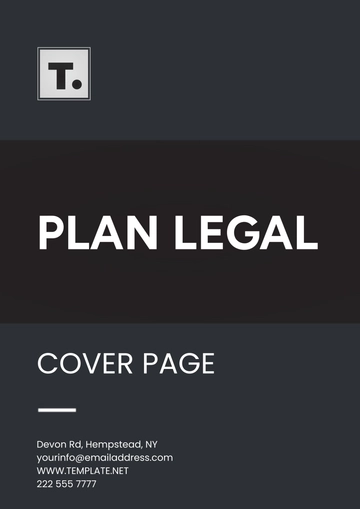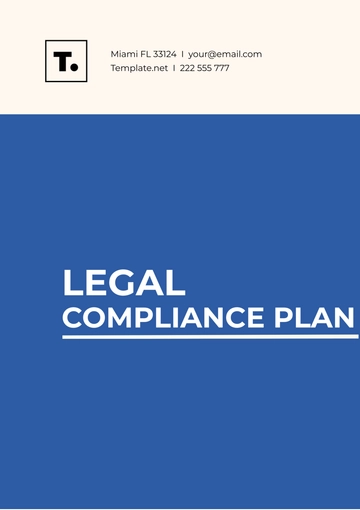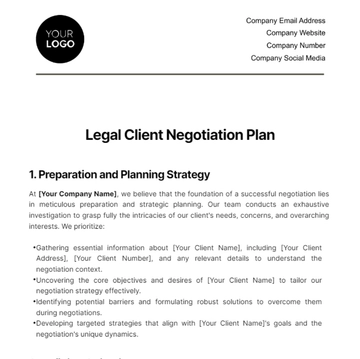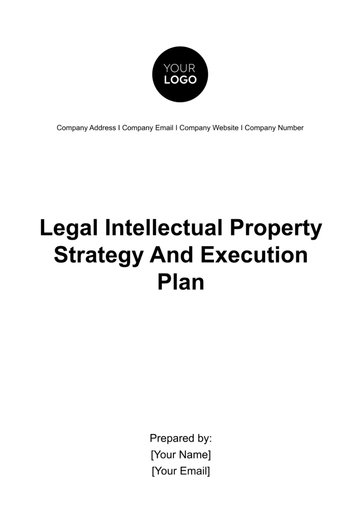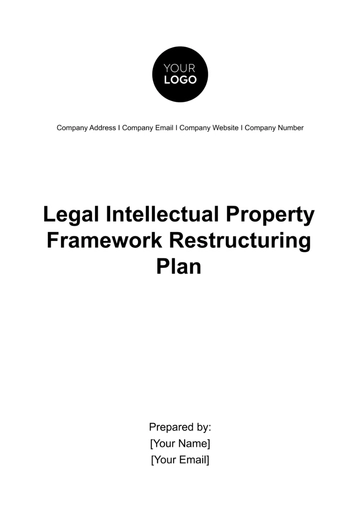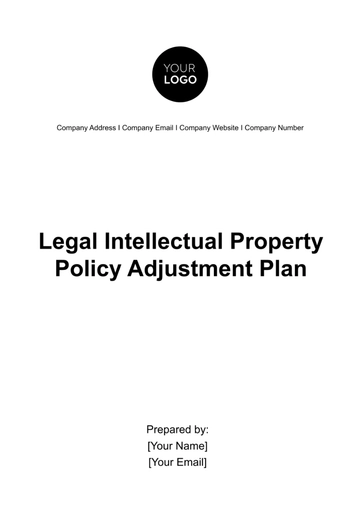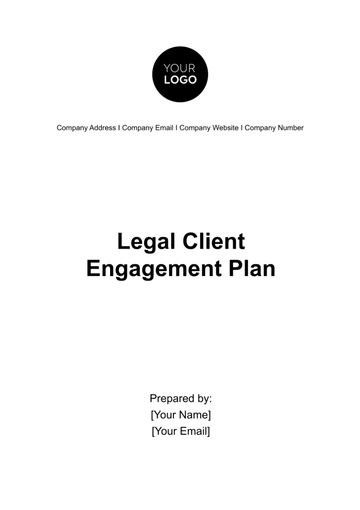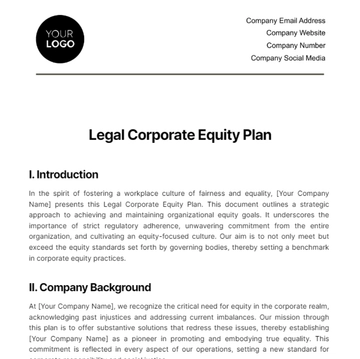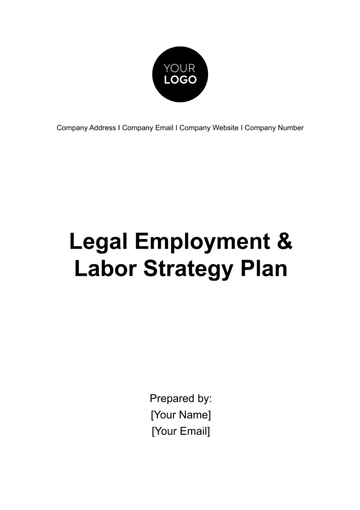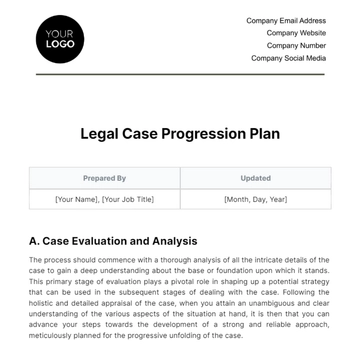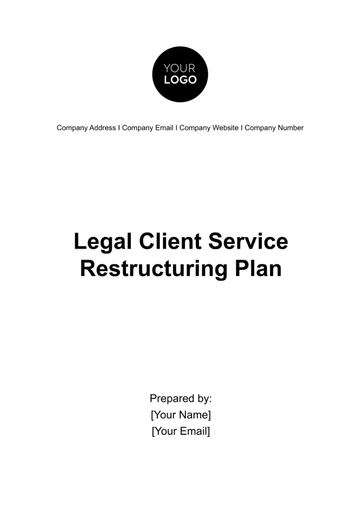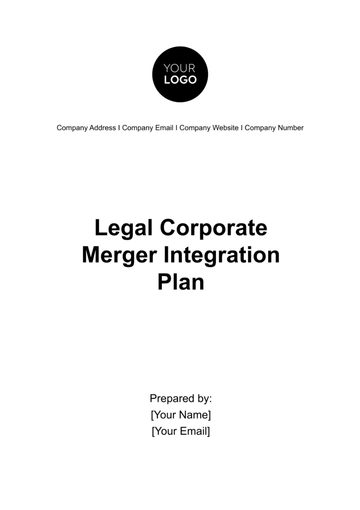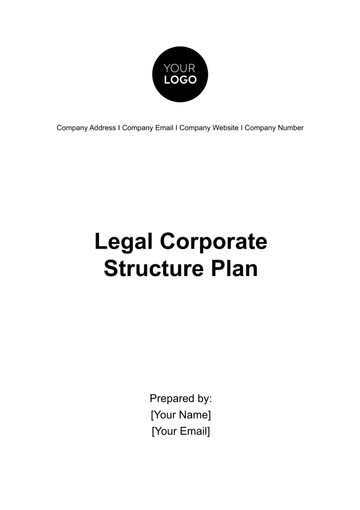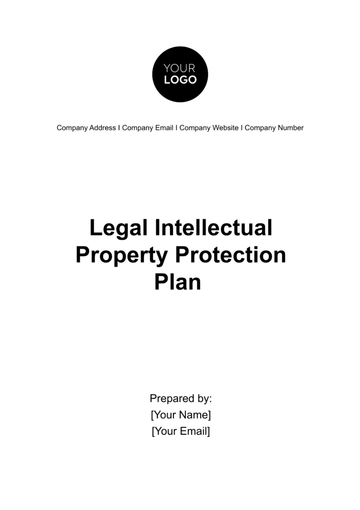Free Legal Employment & Labor Strategy Plan
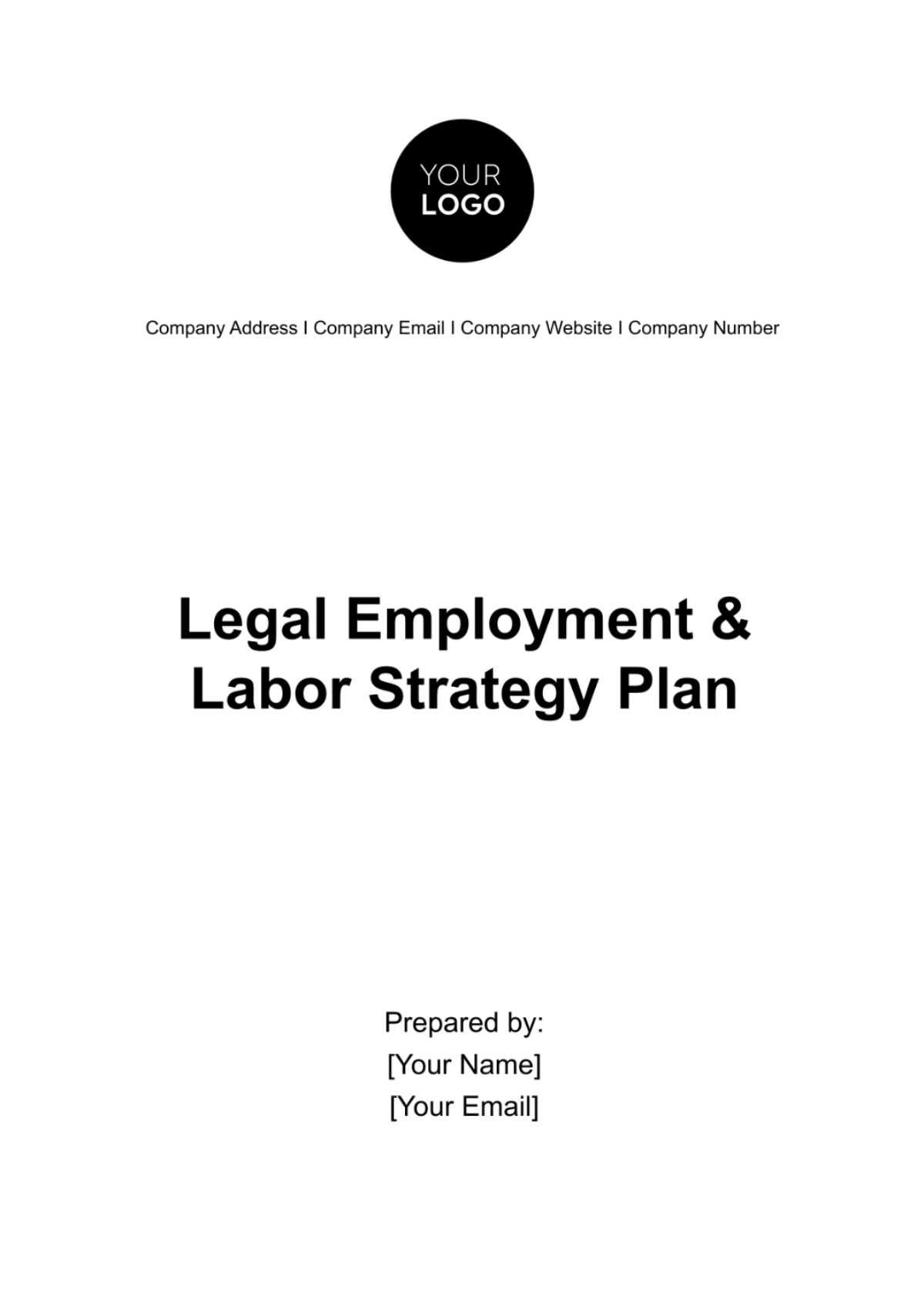
I. Executive Summary
This Legal Employment & Labor Strategy Plan outlines the comprehensive approach [Your Company Name] will undertake to ensure full compliance with all relevant employment and labor laws, foster a positive and inclusive workplace culture, and mitigate the risk of legal disputes. It serves as a blueprint for managing our workforce in alignment with federal, state, and local regulations, while also promoting our core values of integrity, respect, and excellence.
The key strategies highlighted in this plan include the establishment of a robust compliance framework, the implementation of thorough organizational policies and procedures, the adoption of best practices in employment practices, and the development of effective dispute resolution mechanisms. Through the execution of this plan, [Your Company Name] aims to not only meet legal requirements but also enhance employee satisfaction and engagement.
II. Introduction
In today's rapidly evolving legal landscape, the importance of compliance in employment and labor cannot be overstated. [Your Company Name] recognizes that adherence to legal standards is not just a matter of regulatory compliance, but a cornerstone of operational excellence and ethical business conduct. This strategy plan is developed to navigate the complexities of employment and labor laws, ensuring that our business operations are both legally compliant and aligned with our mission to create a supportive and productive work environment.
III. Compliance Framework
A. Federal, State, and Local Laws
To maintain compliance with the multifaceted legal landscape, [Your Company Name] commits to identifying and adhering to all relevant laws and regulations at the federal, state, and local levels. The following table summarizes key areas of legal compliance:
Area of Law | Description | Key Actions |
|---|---|---|
Wage and Hour | Compliance with the Fair Labor Standards Act (FLSA) for minimum wage, overtime pay, and recordkeeping. | Regular audits of payroll practices; training for managers. |
Discrimination and Harassment | Adherence to the Equal Employment Opportunity Commission (EEOC) guidelines to prevent workplace discrimination and harassment. | Implementation of anti-discrimination policies; regular employee training sessions. |
Health and Safety | Compliance with Occupational Safety and Health Administration (OSHA) standards. | Establishment of a workplace safety committee; conducting regular safety audits. |
Privacy | Protection of employee privacy in accordance with state and federal regulations. | Development of a privacy policy; training on handling personal information. |
B. Industry-Specific Regulations
[Your Company Name] operates in [Industry], which subjects us to additional regulatory requirements. We will ensure compliance with these industry-specific regulations through continuous monitoring and adaptation of our practices. Our compliance team will work closely with industry associations and legal advisors to stay abreast of any changes in the regulatory landscape.
IV. Organizational Policies and Procedures
A. Development and Review
[Your Company Name] is committed to developing comprehensive employment policies that reflect our commitment to legal compliance and ethical business practices. These policies will be regularly reviewed and updated to reflect changes in legislation and best practices in human resources management. The review process will involve consultation with legal experts, HR professionals, and key stakeholders to ensure that our policies are both effective and equitable.
B. Implementation and Enforcement
To ensure the effective implementation and enforcement of our organizational policies, [Your Company Name] will undertake the following steps:
Steps | Details |
|---|---|
Policy Distribution | All policies will be made accessible to employees through our intranet and employee handbook. |
Training Programs | We will conduct regular training sessions for both management and employees to ensure understanding and adherence to our policies. |
Monitoring and Reporting | Mechanisms will be put in place to monitor compliance and encourage reporting of any issues or concerns without fear of retaliation. |
V. Employment Practices
A. Hiring and Onboarding
[Your Company Name]’s hiring and onboarding processes are designed to be fair, transparent, and compliant with all legal requirements. This includes:
Job Postings: Ensuring that all job postings are non-discriminatory and accurately reflect the requirements and responsibilities of the position.
Interview Process: Training interviewers on lawful interviewing practices and ensuring that hiring decisions are based on objective criteria.
Employment Contracts: Reviewing and updating employment contracts to ensure they are compliant with current laws and clearly outline terms of employment.
B. Wage and Hour Compliance
To ensure compliance with wage and hour laws, [Your Company Name] will:
Conduct Regular Audits: Regularly review payroll practices to ensure compliance with minimum wage, overtime, and record-keeping requirements.
Classify Employees Correctly: Implement procedures to accurately classify employees as exempt or non-exempt based on FLSA guidelines.
VI. Labor Relations
[Your Company Name] recognizes the importance of maintaining positive and productive relationships with labor unions, where applicable, and ensuring that our practices comply with the National Labor Relations Act (NLRA) and other relevant legislation.
Union Relations: We will engage in good faith bargaining with any recognized unions, respecting the rights of employees to organize and bargain collectively. Our approach will focus on fostering open communication and mutual respect to negotiate contracts that benefit both parties.
Collective Bargaining: Our strategy includes preparing thoroughly for collective bargaining sessions, understanding union demands, and developing proposals that align with our operational capabilities and strategic objectives.
Dispute Resolution: In the event of labor disputes, we will prioritize mediation and arbitration to resolve issues amicably and efficiently, minimizing disruption to our operations.
VII. Dispute Resolution and Litigation Avoidance
A. Internal Dispute Resolution Processes
To address workplace disputes proactively, [Your Company Name] will establish clear procedures for employees to raise concerns and grievances. This includes:
Process | Details |
|---|---|
Open-Door Policy | Encouraging employees to discuss their concerns directly with their managers or HR representatives as a first step. |
Grievance Procedure | Implementing a formal grievance procedure that allows employees to submit their concerns anonymously, if desired, ensuring that all complaints are investigated thoroughly and impartially. |
Feedback and Resolution | Providing timely feedback to employees who raise concerns and ensuring that resolutions are communicated effectively. |
B. External Dispute Resolution
When internal resolution processes do not resolve disputes, [Your Company Name] is committed to exploring external dispute resolution methods such as mediation and arbitration. This approach aims to resolve conflicts without resorting to litigation, focusing on:
Mediation: Engaging a neutral third party to facilitate a resolution that is acceptable to both [Your Company Name] and the employee.
Arbitration: Agreeing to abide by the decision of an arbitrator as a binding resolution to the dispute, when appropriate.
VIII. Data Protection and Privacy
[Your Company Name] is committed to protecting the privacy and security of employee data in compliance with applicable laws and regulations, such as the General Data Protection Regulation (GDPR) for European employees and state-specific privacy laws in the United States.
Methods | Details |
|---|---|
Data Protection Policies | Developing comprehensive data protection policies that outline how employee data is collected, used, stored, and shared. |
Employee Training | Conducting regular training sessions for employees who handle personal data, ensuring they understand their responsibilities and the importance of data protection. |
Data Security Measures | Implementing robust technical and organizational measures to protect against unauthorized access, data breaches, and loss. |
IX. Training and Education
To ensure that [Your Company Name]'s workforce is well-informed about our legal obligations and internal policies, we will implement a comprehensive training program that includes:
Types | Details |
|---|---|
Compliance Training | Mandatory training sessions on employment law compliance, workplace ethics, and data protection for all new hires and annual refresher courses for existing employees. |
Leadership Development | Specialized training for managers and supervisors on topics such as conflict resolution, performance management, and fostering an inclusive workplace. |
Customized Workshops | Tailored training sessions addressing specific needs or changes in legislation, ensuring that our workforce remains agile and informed. |
X. Monitoring and Audit
To uphold the highest standards of legal compliance and operational integrity, [Your Company Name] commits to an ongoing process of monitoring and auditing our employment and labor practices. This rigorous approach involves conducting annual compliance audits to meticulously review our employment practices, policies, and procedures. These audits are designed to identify any areas where we may fall short of legal requirements or our own standards of excellence, ensuring that no aspect of our employment and labor strategy is overlooked. Following each audit, we will swiftly develop detailed action plans to address any identified issues. These plans will outline specific corrective measures, assign responsibility to designated personnel or departments, and set clear timelines for implementation. Moreover, we recognize the importance of adapting to changes in legislation, industry standards, and our own operational needs.
Therefore, our audit process is not merely a mechanism for compliance but also a tool for continuous improvement. By integrating feedback from these audits, responses to employee surveys, and insights into industry best practices, we aim to continually refine and enhance our employment and labor practices. This proactive and comprehensive monitoring and audit strategy is a testament to [Your Company Name]'s commitment to legal compliance, ethical business practices, and the ongoing improvement of our workplace environment.
XI. Action Plan and Timeline
[Your Company Name] will develop a detailed action plan with specific initiatives, responsible parties, and timelines for each component of this strategy. This plan will be reviewed and updated annually to ensure its relevance and effectiveness. Key milestones will include:
Policy Review and Update: Scheduled every six months.
Training Sessions: Conducted quarterly for different target audiences within the organization.
Compliance Audits: Annual audits, with interim reviews as needed based on changes in legislation or business operations.
XII. Conclusion
Through the implementation of this Legal Employment & Labor Strategy Plan, [Your Company Name] is committed to upholding the highest standards of legal compliance and ethical conduct. Our aim is not only to mitigate the risk of litigation but also to foster a workplace culture that values respect, diversity, and fairness. By doing so, we believe that we can achieve our business objectives while also ensuring the well-being and satisfaction of our employees.
- 100% Customizable, free editor
- Access 1 Million+ Templates, photo’s & graphics
- Download or share as a template
- Click and replace photos, graphics, text, backgrounds
- Resize, crop, AI write & more
- Access advanced editor
Strategize your workforce management with Template.net's Legal Employment & Labor Strategy Plan Template. Tailored for HR excellence, this template is fully customizable and editable using our Ai Editor Tool, allowing seamless integration into your business framework. Craft comprehensive strategies to navigate employment and labor challenges effectively. Elevate your HR planning with Template.net's innovative solution.
You may also like
- Finance Plan
- Construction Plan
- Sales Plan
- Development Plan
- Career Plan
- Budget Plan
- HR Plan
- Education Plan
- Transition Plan
- Work Plan
- Training Plan
- Communication Plan
- Operation Plan
- Health And Safety Plan
- Strategy Plan
- Professional Development Plan
- Advertising Plan
- Risk Management Plan
- Restaurant Plan
- School Plan
- Nursing Home Patient Care Plan
- Nursing Care Plan
- Plan Event
- Startup Plan
- Social Media Plan
- Staffing Plan
- Annual Plan
- Content Plan
- Payment Plan
- Implementation Plan
- Hotel Plan
- Workout Plan
- Accounting Plan
- Campaign Plan
- Essay Plan
- 30 60 90 Day Plan
- Research Plan
- Recruitment Plan
- 90 Day Plan
- Quarterly Plan
- Emergency Plan
- 5 Year Plan
- Gym Plan
- Personal Plan
- IT and Software Plan
- Treatment Plan
- Real Estate Plan
- Law Firm Plan
- Healthcare Plan
- Improvement Plan
- Media Plan
- 5 Year Business Plan
- Learning Plan
- Marketing Campaign Plan
- Travel Agency Plan
- Cleaning Services Plan
- Interior Design Plan
- Performance Plan
- PR Plan
- Birth Plan
- Life Plan
- SEO Plan
- Disaster Recovery Plan
- Continuity Plan
- Launch Plan
- Legal Plan
- Behavior Plan
- Performance Improvement Plan
- Salon Plan
- Security Plan
- Security Management Plan
- Employee Development Plan
- Quality Plan
- Service Improvement Plan
- Growth Plan
- Incident Response Plan
- Basketball Plan
- Emergency Action Plan
- Product Launch Plan
- Spa Plan
- Employee Training Plan
- Data Analysis Plan
- Employee Action Plan
- Territory Plan
- Audit Plan
- Classroom Plan
- Activity Plan
- Parenting Plan
- Care Plan
- Project Execution Plan
- Exercise Plan
- Internship Plan
- Software Development Plan
- Continuous Improvement Plan
- Leave Plan
- 90 Day Sales Plan
- Advertising Agency Plan
- Employee Transition Plan
- Smart Action Plan
- Workplace Safety Plan
- Behavior Change Plan
- Contingency Plan
- Continuity of Operations Plan
- Health Plan
- Quality Control Plan
- Self Plan
- Sports Development Plan
- Change Management Plan
- Ecommerce Plan
- Personal Financial Plan
- Process Improvement Plan
- 30-60-90 Day Sales Plan
- Crisis Management Plan
- Engagement Plan
- Execution Plan
- Pandemic Plan
- Quality Assurance Plan
- Service Continuity Plan
- Agile Project Plan
- Fundraising Plan
- Job Transition Plan
- Asset Maintenance Plan
- Maintenance Plan
- Software Test Plan
- Staff Training and Development Plan
- 3 Year Plan
- Brand Activation Plan
- Release Plan
- Resource Plan
- Risk Mitigation Plan
- Teacher Plan
- 30 60 90 Day Plan for New Manager
- Food Safety Plan
- Food Truck Plan
- Hiring Plan
- Quality Management Plan
- Wellness Plan
- Behavior Intervention Plan
- Bonus Plan
- Investment Plan
- Maternity Leave Plan
- Pandemic Response Plan
- Succession Planning
- Coaching Plan
- Configuration Management Plan
- Remote Work Plan
- Self Care Plan
- Teaching Plan
- 100-Day Plan
- HACCP Plan
- Student Plan
- Sustainability Plan
- 30 60 90 Day Plan for Interview
- Access Plan
- Site Specific Safety Plan

